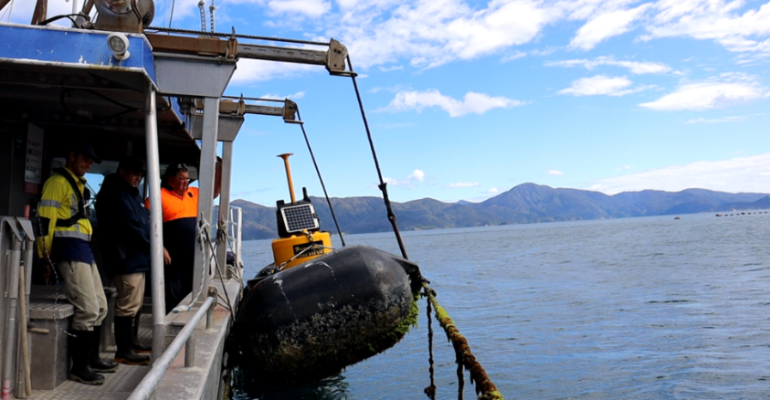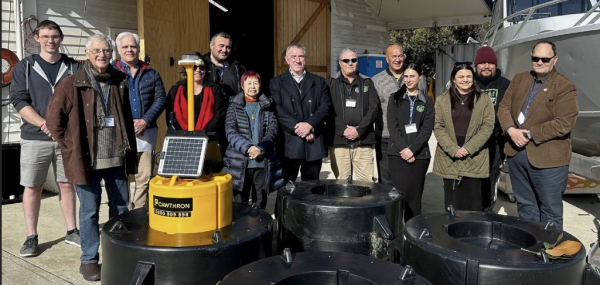Connect farm to desk: using data to bring iwi, scientists and marine farmers together
11 June 2024 | Read time: 7 minutes

The 24th November 2023 was an important date for research analyst Thomas Shorrock. It marked the culmination of a SfTI ‘ending with impact’ (EWIP) project called Ocean Intelligence that he’s been heavily involved with. On that day, the project team were deploying a novel environmental sensor technology (NEST) float to a Ngāti Rārua-owned marine mussel farm at Admiralty Bay in the Marlborough Sounds.
“The data gathered from the NEST float will be used to remotely monitor the health of the water, to inform decisions about our mussel farming operations,” explains Shorrock. “The launch was a great day. Karakia was observed throughout the process by our cultural Pou ‘Reo Mauri Ora’ Pohe Stephens, with support from one of our NMIT Aquaculture students Te Rito Hughes. The team were very respectful, including our mussel farmer. This project is a combination of our Matauranga Māori and scientific research.”

Tokomaru Research Centre, Ocean Intelligence team and Clearwater Mussels team.
Ocean Intelligence is a partnership between the Tokomaru Research Centre – a new institute established by Te Rūnanga o Ngāti Rārua1 – Clearwater Mussels who operate the farm for the iwi, the Cawthron Institute, and data science specialists, Oceanum. A spinout from the Precision Farming Technologies for Aquaculture Spearhead, the project is utilising a suite of proven sensors and bespoke software to create data-heavy digital dashboards for marine farmers.
“The goal is to transition the aquaculture industry from one that’s largely based on experience, into something more data-driven and technology based,” says Cawthron’s Dr Chris Cornelisen. “For a mussel farmer working in a dynamic, super high-energy environment like the ocean, it’s not possible for them to just walk out to the paddock to check things. This project's been about bringing the farm to the desk; turning the lights on for the farmers, so they can manage their farms much more effectively and efficiently.”
“The goal is to transition the aquaculture industry from one that’s largely based on experience, into something more data-driven and technology based,” says Cawthron’s Dr Chris Cornelisen. “For a mussel farmer working in a dynamic, super high-energy environment like the ocean, it’s not possible for them to just walk out to the paddock to check things. This project's been about bringing the farm to the desk; turning the lights on for the farmers, so they can manage their farms much more effectively and efficiently.”
At Admiralty Bay, the mussels grow on lines that stretch from the surface down to 20 m. The Ocean Intelligence sensors continuously monitor the water temperature at different depths, to ensure conditions are suitable for mussel growth. Precise location data is also collected for each line by the NEST float, and lights and the batteries needed to power them are monitored too. Longer-term, additional sensors could be added, including those that measure ocean acidity and water turbidity (or clarity). The float housings are 3-D printed at Cawthron, which significantly reduces the cost of materials, making the platforms cheaper than those available from commercial suppliers. The data collected from all of the sensors in the NEST float is collated into a single online dashboard, providing farmers with data even when they are far from their mussel farm.
This is a valuable new tool for Ngāti Rārua, and Shorrock, who joined Tokomaru specifically to work on the Ocean Intelligence project, says the experience of deploying the float has been very positive, “I had a lot of learning to do from the start, but what’s helped is that everyone involved has been very open-armed and keen to be collaborating with us. We have monthly hui with them, and I visit the team at the Cawthron boatshed – their innovation hub – regularly. They’ve always responded to my requests, and helped us solve issues. It’s been fabulous.”
Since its earliest inception, the goal of the Ocean Intelligence (OI) project was to turn great research into a commercial enterprise, for the benefit of New Zealand, as Cornelisen explains, “From day one, we’ve treated OI as a new company. It wasn’t about scientific papers. It was about building real solutions that can be commercialised and scaled.” The Spearhead project demonstrated to Cornelisen that it was the data itself – rather than the hardware used to collect it – that was particularly valuable. “The information we’re providing helps farmers to make decisions. Bringing in ocean data engineers from Oceanum was a step change for this. We now use a ‘data mesh’ that allows you to bring in lots of different data sets, whether it's forecasts or measurements, satellite imagery, whatever, and do your analytics on it in one place.”
From day one, we’ve treated OI as a new company. It wasn’t about scientific papers. It was about building real solutions that can be commercialised and scaled.”
Shorrock says that following on from the project, Te Rūnanga o Ngāti Rārua have expressed interest in rolling out the technology further. “We have a shared interest, with another Tainui iwi, in a mussel farm at Snapper Point. That'll be our next go-to – we’d like to put a NEST float there.” The iwi is also in conversation with several universities, and was recently awarded funding from the Vision Mātauranga Capability Fund. The aim of that work is to investigate the impact of climate change on Ngāti Rārua land and water, and to establish environmental management responses supported by scientific research, data from the data mesh platform, and traditional knowledge.
For Cornelisen, the long-term implications of their data mesh could be significant. “Ultimately there's a much wider need out there for data-driven solutions. New Zealand has the fifth largest ocean marine economic zone and yet we're one of the few maritime OECD countries without a dedicated ocean observing system. The work we’ve been doing with SfTI is basically our way of bootstrapping tech innovation for that system, so that it can ultimately be used by everyone.”